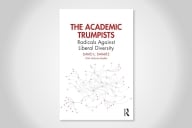You have /5 articles left.
Sign up for a free account or log in.
Teaching is the primary source of income for nearly three-quarters (73 percent) of adjunct faculty members, and two-thirds have actively sought a tenure-track position. Some 38 percent have been on the market for a tenure-track job for five or more years. Those are some of the preliminary findings of a survey of part-time faculty members released Friday by the New Faculty Majority, a national adjunct advocacy group.
In addition to dispelling certain “myths” about adjunct faculty members -- namely that most of them have other jobs and teach on the side -- the survey asked other questions that New Faculty Majority says have yet to appear in a national poll of adjunct professors.
Marisa Allison, a researcher for the organization and a Ph.D. candidate in sociology at George Mason University, said that some of the more troubling findings relate to uncompensated work. For example, 31 percent of respondents reported that a department or college that they’ve work for has included their scholarship, publications or grants received in official reports regarding faculty productivity, even though 94 percent reported not being compensated for that intellectual work.
Respondents also said they’d received little to no training for campus safety protocols -- an increasing area of concern for many colleges in light of campus rape discussions, campus shootings and student mental health concerns. For example, 44 percent of respondents said they would not know what to do in the event of an emergency situation on campus. About the same proportion (43 percent) said they would not know where to direct students who had been victims of a crime on campus.
About 45 percent said they would not know where the institution would want them to direct students who’d been the target of discrimination or sexual harassment, or what to do about students they felt were a threat to themselves or others. Some 41 percent said they wouldn’t know what to do if a student came to them showing signs of depression or other mental health issues. A majority of respondents, meanwhile -- 73 percent -- said that students had in fact come to them showing signs of depression or other mental illness. An even higher proportion said students had asked them for nonacademic advice, counseling or support. And 40 percent of respondents said they’ve taught a student they felt was a threat to themselves or others, or that they had concerns about their personal safety on campus.
Allison said that the online survey attracted 400 respondents during Campus Equity Week, which ended Friday, with a disproportionate number of respondents coming from the West and East Coasts. So while the survey wasn't representative, she said, it shines light on issues previously absent from the national conversation about adjuncts. New Faculty Majority last conducted its back-to-school survey in 2011, and many of the questions that were asked previously yielded similar responses this year. For example, both surveys found that professors had little lead time to prepare for courses; in the best-case scenario, about one-third of respondents then and now said they had less than three weeks to get ready to teach a class.
Maria Maisto, president of the New Faculty Majority, said the survey demonstrates the need for a comprehensive national study of postsecondary faculty. She and other advocates were in Washington last week asking members of Congress to reinstate the Education Department's National Study of Postsecondary Faculty, which was last conducted in 2004. While the Integrated Postsecondary Education Data System collects basic demographic information about instructors, she said, the former study provided a more in-depth look at who was doing the teaching, under what circumstances.
Robin Sowards, an adjunct professor of English in the Pittsburgh area and a researcher on part-time faculty issues for the United Steelworkers, a union working with adjuncts in the region, said New Faculty Majority's data demonstrate that "this current business model is not sustainable in the long run."









